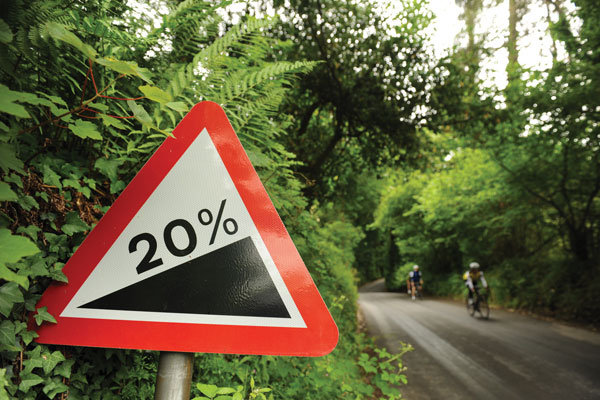Hill intervals: improve your climbing

I'm interested in anything you can recommend to improve my climbing. It's definitely my weakness; I can usually hang with my local group until we get to the hills, where I really start to struggle. I'm not particularly heavy but just can't seem to get up the hills. Are there any hill intervals that can help improve my climbing strength?
Mark, Derbyshire
Coaches often use hill training sessions to increase their rider's muscular strength because of the increased resistance hills offer. Hill intervals are also ideal for increasing your aerobic capacity.
Find a hill of around six-eight per cent gradient and make sure you are warmed up thoroughly before you begin. Approach the bottom of the hill, drop the bike into a big gear and, as you hit the bottom of the hill, jump out of the saddle and accelerate up to top speed for between 30 seconds to a minute (if the hill is longer, simply pick a marker part way up at which you stop).
Effort should be about 95 per cent of max but, if using heart rate, be aware the interval will possibly finish before your heart rate hits its peak. For that reason, a perceived effort rating might be more appropriate. At this point, turn around and cruise back to the bottom, and spin a light gear until heart rate returns to below about 65 per cent of max before repeating the interval.
Once you've established this basic protocol you can begin progressing the session, using harder gears and varying the number of intervals to improve your power and short-term muscular endurance.
As for improving your performance on longer climbs, this is simply a case of using different gradients and heart rates.
For example, climbing performance at lactate threshold can be improved by riding extended climbing intervals for around 10 minutes at 80-90 per cent max heart rate with 10 minutes' recovery between each climb. Also be aware of the technique requirements.
Get The Leadout Newsletter
The latest race content, interviews, features, reviews and expert buying guides, direct to your inbox!
Longer climbs should be practised sitting in the saddle and focusing on smooth pedalling technique, a ‘quiet' upper body and higher cadence in order to develop climbing efficiency.
Adding a couple of long and short hill interval sessions like these into your training programme will have a significant effect on your climbing and more general cycling performance. Just be aware that they are very demanding physically and you need to be sufficiently recovered from previous sessions in order to benefit most from them, so plan them carefully into your schedule.
Huw Williams is a BC Level 3 coach
This article was first published in the January 24 issue of Cycling Weekly. You can also read our magazines on Zinio, download from the Apple store and also through Kindle Fire.

Thank you for reading 20 articles this month* Join now for unlimited access
Enjoy your first month for just £1 / $1 / €1
*Read 5 free articles per month without a subscription

Join now for unlimited access
Try first month for just £1 / $1 / €1
Founded in 1891, Cycling Weekly and its team of expert journalists brings cyclists in-depth reviews, extensive coverage of both professional and domestic racing, as well as fitness advice and 'brew a cuppa and put your feet up' features. Cycling Weekly serves its audience across a range of platforms, from good old-fashioned print to online journalism, and video.
-
 'I'll take a top 10, that's alright in the end' - Fred Wright finishes best of British at Paris-Roubaix
'I'll take a top 10, that's alright in the end' - Fred Wright finishes best of British at Paris-RoubaixBahrain-Victorious rider came back from a mechanical on the Arenberg to place ninth
By Adam Becket Published
-
 'This is the furthest ride I've actually ever done' - Matthew Brennan lights up Paris-Roubaix at 19 years old
'This is the furthest ride I've actually ever done' - Matthew Brennan lights up Paris-Roubaix at 19 years oldThe day's youngest rider reflects on 'killer' Monument debut
By Tom Davidson Published